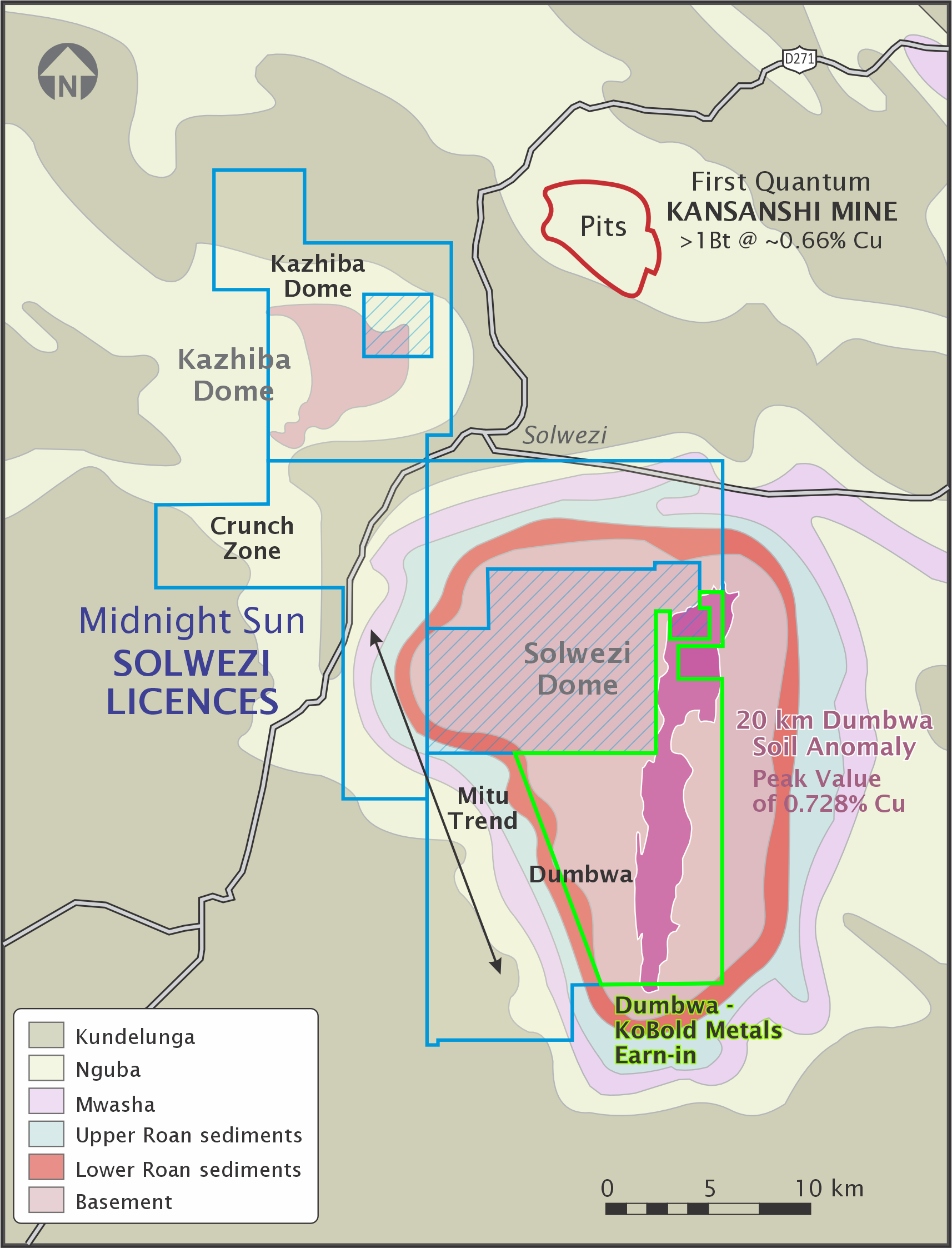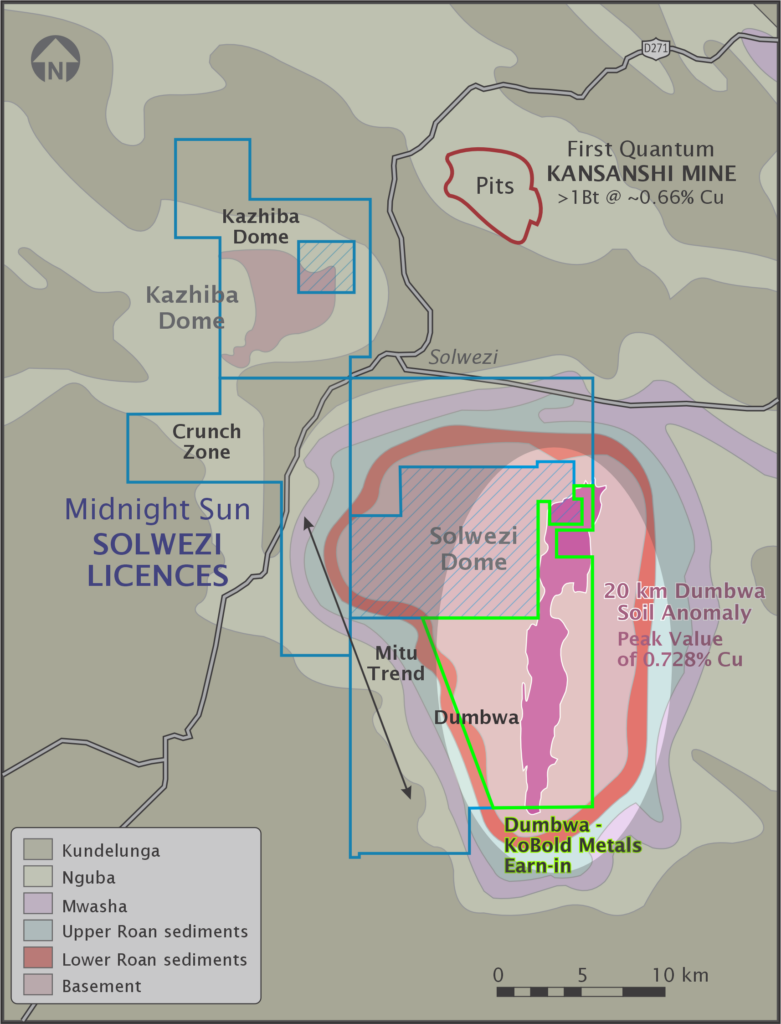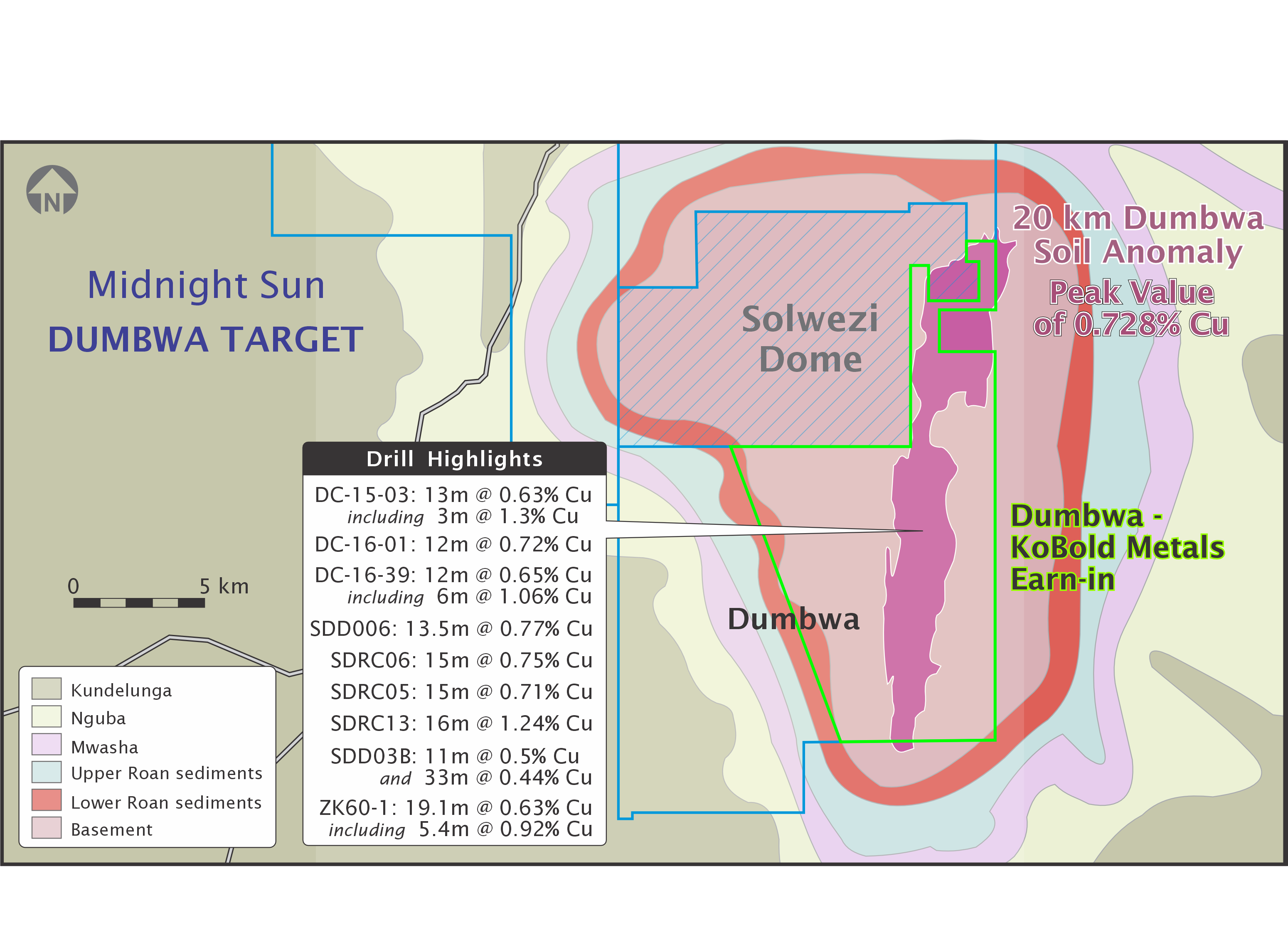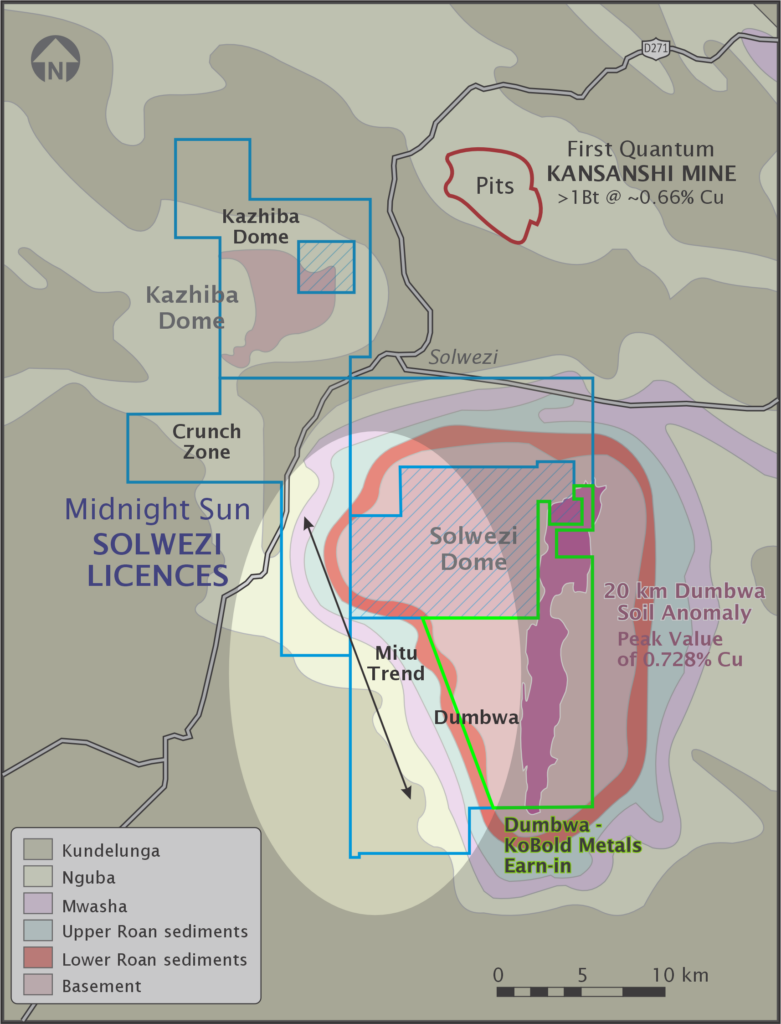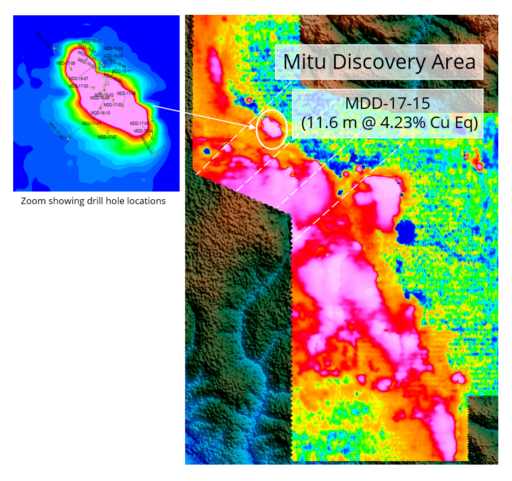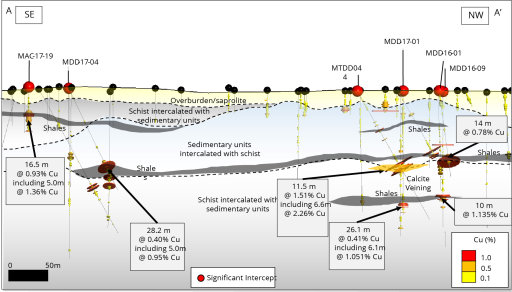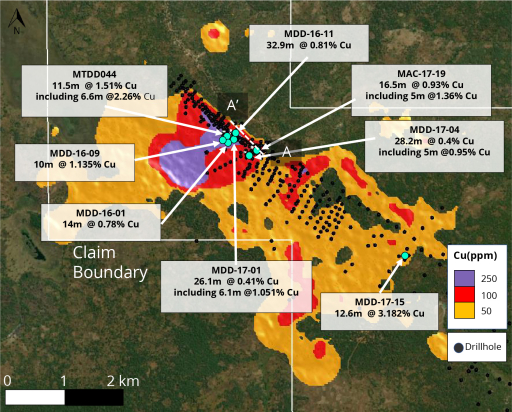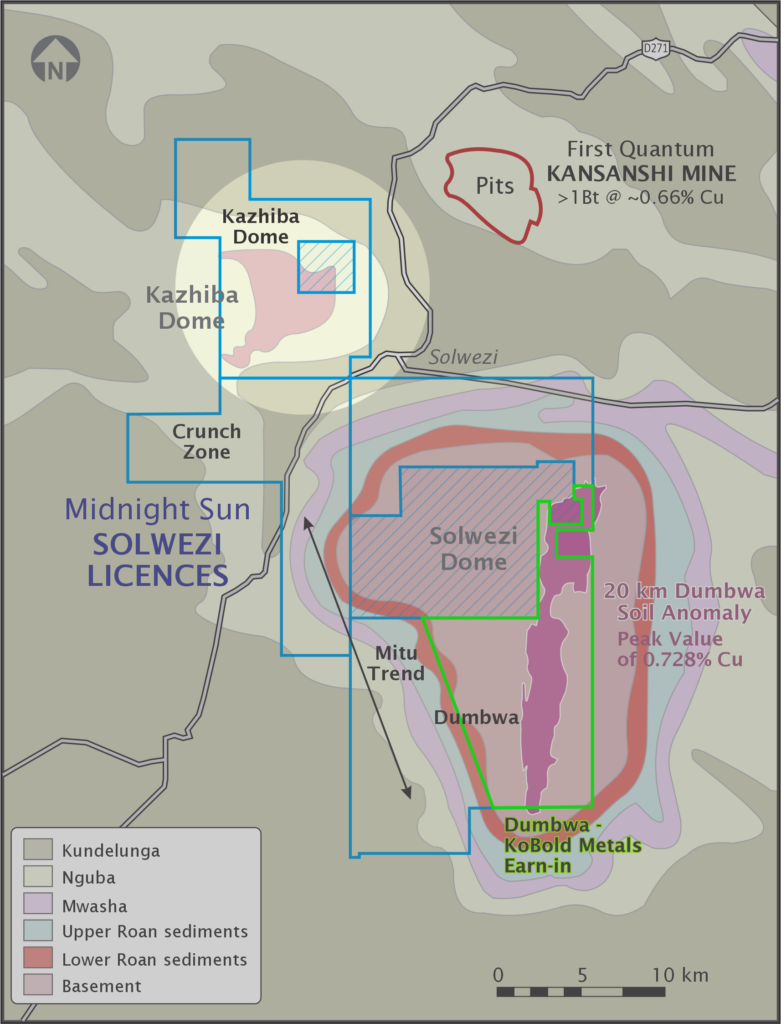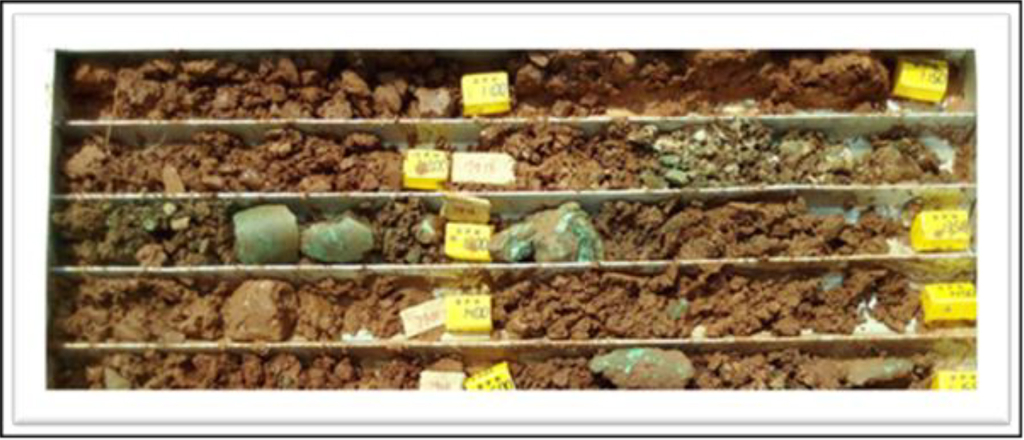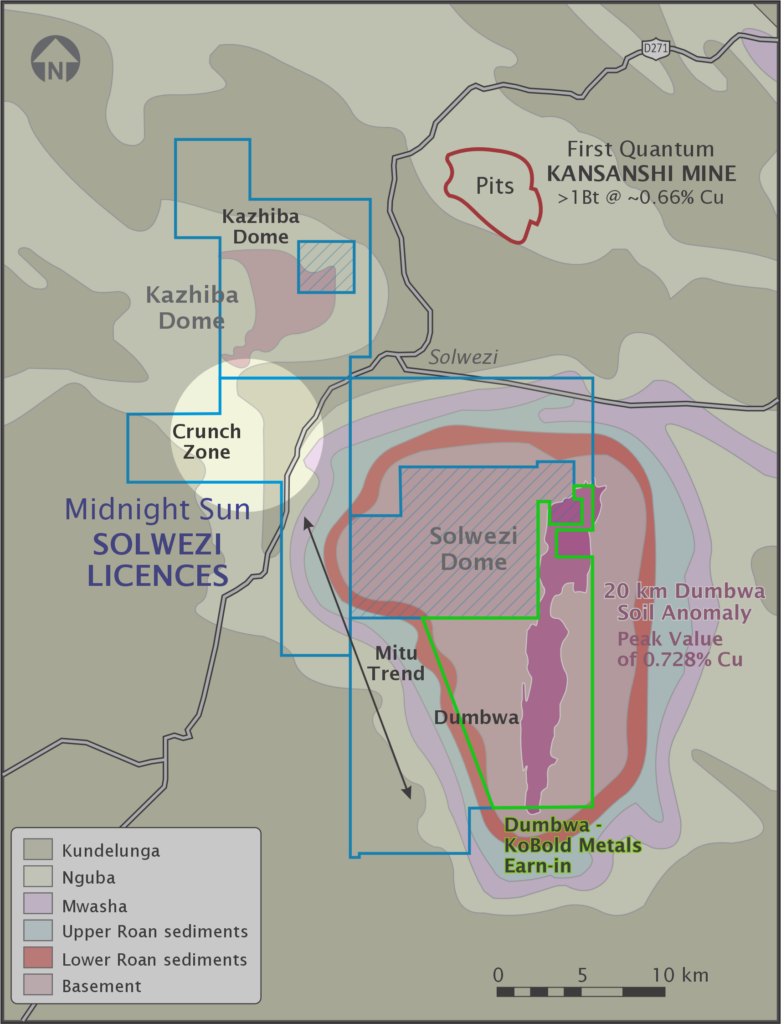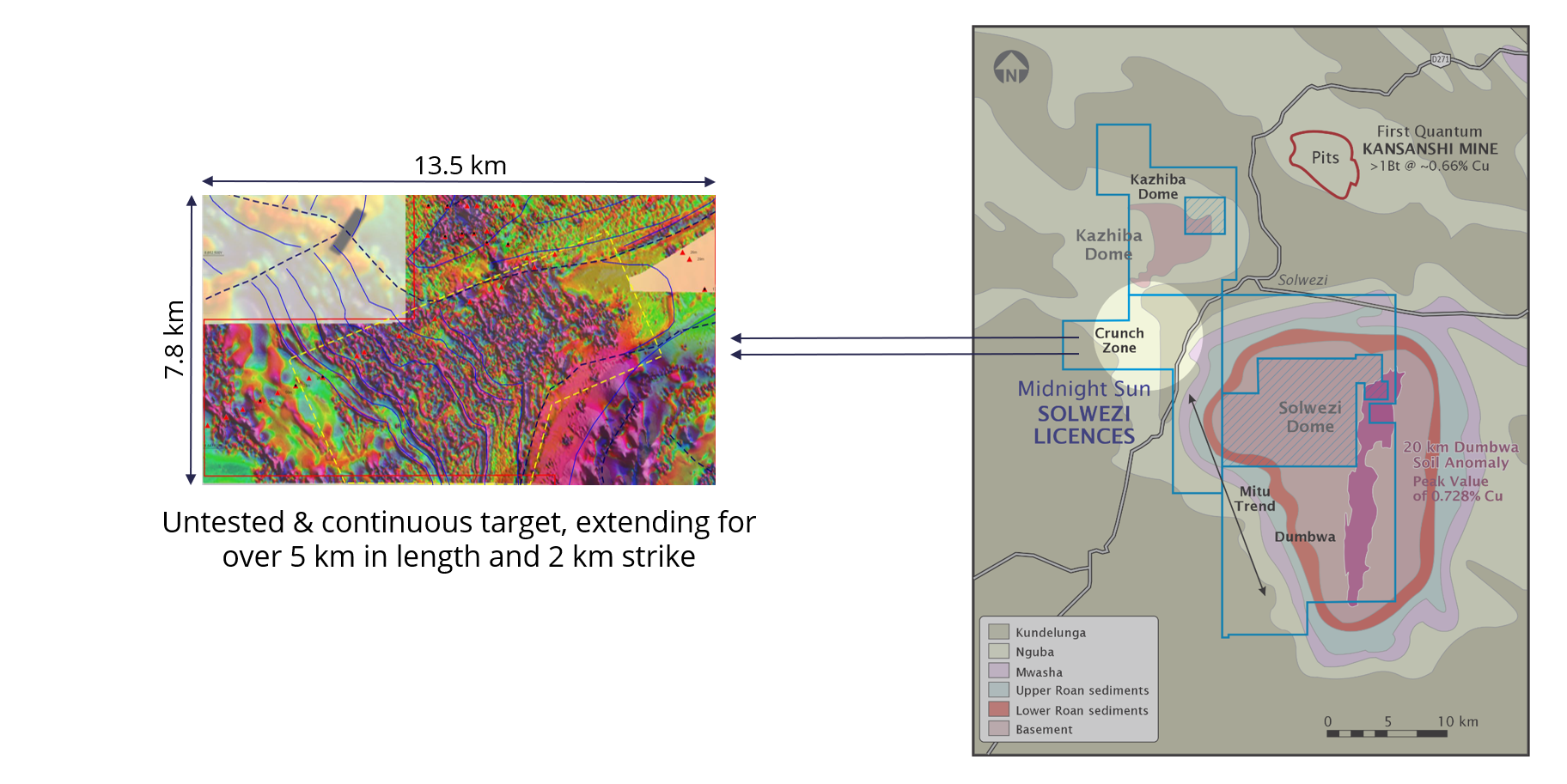Our vast 506 km² property features numerous structural and mineralized targets and our team have made multiple significant discoveries on our property to date. We have identified 4 separate target areas which we believe to host unique geological systems, each with the potential for a significant copper discovery. The targets are Dumbwa, Mitu, Kazhiba (22 Zone) and Crunch Zone.
Dumbwa
Midnight Sun & Kobold Metals Earn-In
Dumbwa is a Tier-One exploration target, featuring a remarkable copper soil anomaly. This continuous, high-grade, copper-in-soil anomaly tracks for over 20 kilometres along strike and exceeds 1 kilometre in width, with peak values up to 0.73% copper. Extensive soil sampling and shallow drilling have established extensive oxide copper potential, while also demonstrating that further drill campaigns guided by structural controls are necessary to establish dip direction, continuity, size, and scale. Our team has discovered multiple stacked mineralized horizons, which we believe are analogous to Barrick’s Lumwana Mine, located just a short distance to the west.
In January 2024, Midnight Sun joined forces with Bill Gates-backed KoBold Metals, to systematically explore Dumbwa and discover its full potential.
Midnight Sun & KoBold Metals Earn-In at Dumbwa Target
Signed in January 2024, the Dumbwa Earn-In Agreement allows KoBold Metals to earn a 75% interest in Dumbwa by incurring USD$15 million in exploration expenditures and making cumulative cash payments to Midnight Sun of USD$500,000 over 4.5 years.
Exploration expenditures under the Earn-In are as follows:
- Year 1– Completion of a minimum of 2,000 metres of diamond core drilling
- Year 2 – USD $4,000,000 of exploration
- Year 3 – USD $7,000,000 of cumulative exploration
- Year 4.5 – USD $15,000,000 of cumulative exploration
KoBold Metals Company, a US-based exploration and mining company, is advancing 60 active projects spanning 4 continents. Founded in 2018, KoBold is backed by world-class technology investors including Breakthrough Energy Ventures (initiated by Bill Gates), and Silicon Valley venture capital firm Andreessen Horowitz, as well as institutional investors such as T. Rowe Price and the Canadian Pension Plan Investment Board. KoBold leverages artificial intelligence through proprietary analytical tools and big data to improve and accelerate the exploration process.
KoBold has assembled KoBold has one of the top global sediment-hosted copper teams – including Chief Geologist, Dr. David Broughton, a world-renowned expert in sediment hosted copper deposits. Dr. Broughton is credited with leading the discoveries of both Kamoa and Platreef, as well as serving as Geologist and Project Manager for Kansanshi’s pre-feasibility project, which became Zambia’s largest producing copper mine and is adjacent to the Solwezi Project. KoBold’s team of top-tier geologists will work diligently to unlock Dumbwa’s potential.
Dumbwa in detail
Successive campaigns of soil sampling and shallow Air Core drilling have tested oxide copper potential and limited diamond drilling has returned positive results. During 2015 and 2016, 50 air-core and 6 diamond drill holes were completed at Dumbwa. The strong north-south copper anomaly indicates a high degree of structural control with potential cross-cutting fault zones adding to the complexity of the regional geology. Based on the Company’s interpretation and past drill results, Dumbwa is a target worth pursuing at depth.
The Dumbwa mineralization is located within the highly folded and faulted Pre-Katanga Basement rock of the Solwezi Dome. The dominant lithology of the mineralized zone is fine to medium grained quartz biotite muscovite garnet “basement” gneisses that become schistose in localized areas. Surface mineralization is associated with intense potassic alteration of the basement gneisses. Mineralization appears to be structurally controlled and occurs as multiple zones of disseminated and veinlet hosted Cu of hydrothermal origin. Cu mineralization occurs as malachite within the oxidized zone, and chalcopyrite, bornite and minor chalcocite within the sulphidized zone.
Mitu
Mitu is a target area located in the southwestern portion of our Solwezi Project. Early exploration at Mitu identified “ore shale” type mineralization on the flank of the Solwezi Dome, crosscut by Kansanshi style veins. A series of near surface Cu-Co-Ni-Au intercepts, identified and confirmed copper-cobalt mineralization, including an impressive drill intercept of 11.6 metres grading 3.44% Copper. Additional drill results included:
- MDD-16-01 – 8.0 m of 1.22% Cu, 0.09% Co, and 0.05% Ni and 14.0 m of 1.02% Cu, 0.03% Co, 0.06% Ni
- MDD-16-06 – 30.3 m of 0.49% Cu, 0.03% Co, and 0.05% Ni and 9.0 m of 0.49% Cu, 0.02% Co, 0.03% Ni
- MDD-16-09 – 9.4 m of 1.03% Cu, 0.14% Co, and 0.04% Ni
- MDD-16-11 – 28 m of 0.82% Cu, 0.03% Co, and 0.05% Ni
The discovery of structurally controlled Kansanshi-style mineralized veins represented an additional mineralizing event in the area and drilling delineated a 1 kilometre by 500 metre zone of mineralization which remains open. A VTEM survey carried out over the target delineated multiple conductive zones, all occurring in favourable geology, over more than 17 kilometres on strike.
Further results from drilling carried out in 2022 confirmed a new and exciting revelation, concluding that copper mineralisation intercepted at Mitu is associated with cobalt, nickel, and anomalous gold. This suite of metals is comparable in mineralization style and grade to that at First Quantum’s Sentinel Mine, located approximately 120 kilometres west of Midnight Sun’s Solwezi Project. This new discovery provides proof of concept and revealed more insight into the mineralisation at Mitu, strengthening our conviction that more than one multi-generational copper deposit may exist on our 506 square kilometre property, and this establishes a new analog for Mitu.
Mitu in detail
The Mitu area was targeted for drilling as a potential location of ore shale type base metal mineralization based on evidence from geochemical and geological surveys conducted by the Company and previous operators between 2010 and 2015. Ore shale mineralization is the dominant form of copper, cobalt, and nickel deposition in the Zambia-Congo Copper Belt, the second largest copper production area in the world.
Mineralization is associated with shale units which form chemical and physical “traps” for base metals at or near the favourable contact between the Upper and Lower Roan units. This contact zone along the western flank of the Solwezi Dome extends for over 17 kilometres on the Company’s License areas. Diamond drilling has confirmed the association of copper, cobalt, nickel, and gold with the carbonaceous shales, returning intercepts of up to 3.44% Copper over 11.4 metres. Further exploration work is required to delineate the geometry of the sub-basin to successfully target the prospective carbonaceous shale unit.
2022 Drill highlights include
| Hole | True Width (m) | Cu (%) | Co (%) | Ni (%) |
|---|---|---|---|---|
| MTDD044 INCL INCL | 11.50 4.15 5.80 | 1.41 1.29 1.86 | 0.11 0.13 0.07 | 0.03 0.09 0.02 |
| MTDD045 | 7.30 | 0.58 | 0.02 | 0.02 |
| MTDD047 | 26.10 | 0.32 | 0.07 | 0.05 |
| MTDD048 | 22.25 | 0.39 | 0.01 | 0.01 |
Extensive soil sampling and shallow drilling have also established extensive oxide copper potential at Mitu.
Kazhiba (22 Zone)
Kazhiba, which features our high grade 22 Zone, is located 20 kilometers northwest of the Solwezi Dome and is less than 10 kilometres from the western mine gate of First Quantum’s Kansanshi Mine complex. Kazhiba is underlain by a previously undiscovered basement dome similar to those at both Kansanshi and Solwezi. Domes are believed to be associated with the copper mineralization at nearby mines, including both First Quantum’s Kansanshi and Sentinel mines as well as Barrick’s Lumwana Mine.
The 22 Zone was discovered by follow up shallow drilling in 2012 over a subtle copper anomaly with thick overburden. The discovery hole intersected 11.3 metres of 5.71% Copper, near surface. Additional intercepts include 21 metres of 3.26% Copper and 6.4 metres of 5.08% Copper.1 Drill campaigns in 2013 (reverse circulation) and 2014 (diamond drilling) extended the high grade, near surface discovery. Drilling has now confirmed a high-grade copper oxide blanket, the source of which is yet to be found.
Kazhiba in detail
In an attempt to detect the underlying source of the oxide mineralization at the 22 Zone, 6.7 kilometres of NSAMT geophysics was run in the vicinity, and a conductive zone was indicated. To date, this conductive zone has not been drill tested.
It is currently thought that the 22 Zone and environs may be underlain by a basement dome similar to those at Kansanshi and Solwezi. This doming is believed to be intimately associated with the processes resulting in the copper mineralization at those sites.
Drill highlights include
| Hole | True Width (m) | Cu (%) |
|---|---|---|
| SLZ-13-RC-002 | 21.0 | 3.26 |
| SLZ-14-DD-010 | 11.3 | 5.71 |
| SLZ-14-DD-005 | 6.4 | 5.08 |
| SLZ-14-DD-001 | 4.5 | 6.27 |
Underlain by a previously undiscovered basement dome similar to those at Kansanshi and Solwezi. Domes are believed to be associated with the copper mineralization at each of Kansanshi, Lumwana, and Sentinel.
Crunch Zone
The Crunch Zone exploration target is situated between the Kazhiba Dome in the northwest and the Solwezi Dome in the southeast. This newly identified structural target features a wedged fan of tight structural folds, located between domal structures, and linked to Kansanshi via a succession of sedimentary host rock. A VTEM survey identified the largest untested continuous EM conductive target/anomaly on the property, and this trend occurs in the same stratigraphy as that surrounding the neighbouring Kansanshi Mine. The anomaly remains largely untested & continuous for over 5 kilometres in length and 2 kilometres on strike. The sheer size and scale demonstrated by this anomaly, clearly indicates that appropriate investigation and attention is warranted. This conductive trend represents a potential new discovery at the Crunch Zone.
Crunch in detail
Based on geophysical data, it appears a northeast trending wedge of Copperbelt strata is ‘crunched’ between the domes showing interference fold patterns that abruptly terminate against the domal structures. An analysis of a VTEM electromagnetic survey identified the largest untested continuous EM conductive target/anomaly on the property and suggests that mineralized fluids may have migrated along major faults or thrusts which occurred where the Copperbelt strata encountered the dome structures.

